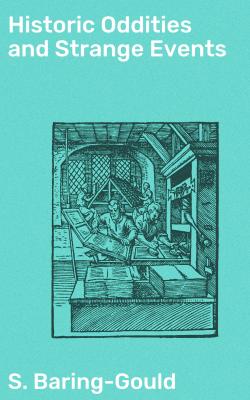Historic Oddities and Strange Events. S. Baring-Gould
Чтение книги онлайн.
Читать онлайн книгу Historic Oddities and Strange Events - S. Baring-Gould страница
 tion>
tion>S. Baring-Gould
Historic Oddities and Strange Events
Published by Good Press, 2021
EAN 4057664635495
Table of Contents
The Disappearance of Bathurst.
The Wonder-Working Prince Hohenlohe.
PREFACE.
A reader of history in its various epochs in different countries, comes upon eccentric individuals and extraordinary events, lightly passed over, may be, as not materially affecting the continuity of history, as not producing any seriously disturbing effect on its course. Such persons, such events have always awakened interest in myself, and when I have come on them, it has been my pleasure to obtain such details concerning them as were available, and which would be out of place in a general history as encumbering it with matter that is unimportant, or of insufficient importance to occupy much space. Two of the narratives contained in this work have appeared already in the "Cornhill Magazine," but I have considerably enlarged them by the addition of fresh material; some of the others came out in the "Gentleman's Magazine," and one in "Belgravia." With only two of them—"Peter Nielsen" and "A Wax and Honey-Moon"—are the authorities somewhat gone beyond and the facts slightly dressed to assume the shape of stories.
S. Baring Gould.
Lew Trenchard, N. Devon,
July, 1889.
HISTORIC ODDITIES.
The Disappearance of Bathurst.
The mystery of the disappearance of Benjamin Bathurst on November 25, 1809, is one which can never with certainty be cleared up. At the time public opinion in England was convinced that he had been secretly murdered by order of Napoleon, and the "Times" in a leader on January 23, 1810, so decisively asserted this, that the "Moniteur" of January 29 ensuing, in sharp and indignant terms repudiated the charge. Nevertheless, not in England only, but in Germany, was the impression so strong that Napoleon had ordered the murder, if murder had been committed, that the Emperor saw fit, in the spring of the same year, solemnly to assure the wife of the vanished man, on his word of honour, that he knew nothing about the disappearance of her husband. Thirty years later Varnhagen von Ense, a well-known German author, reproduced the story and reiterated the accusation against Napoleon, or at all events against the French. Later still, the "Spectator," in an article in 1862, gave a brief sketch of the disappearance of Bathurst, and again repeated the charge against French police agents or soldiers of having made away with the Englishman. At that time a skeleton was said to have been discovered in the citadel of Magdeburg with the hands bound, in an upright position, and the writer of the article sought to identify the skeleton with the lost man.[1]
We shall see whether other discoveries do not upset this identification, and afford us another solution of the problem—What became of Benjamin Bathurst?
Benjamin Bathurst was the third son of Dr. Henry Bathurst, Bishop of Norwich, Canon of Christchurch, and the Prebendary of Durham, by Grace, daughter of Charles Coote, Dean of Kilfenora, and sister of Lord Castlecoote. His eldest brother, Henry, was Archdeacon of Norwich; his next, Sir James, K.C.B., was in the army and was aide-de-camp to Lord Wellington in the Peninsula.
Benjamin, the third son of the bishop, was born March 14, 1784,[2] and had been secretary of the Legation at Leghorn. In May, 1805, he married Phillida, daughter of Sir John Call, Bart., of Whiteford, in Cornwall, and sister of Sir William Pratt Call, the second baronet. Benjamin is a Christian name that occurs repeatedly in the Bathurst family after the founder of it, Sir Benjamin, Governor of the East India Company and of the Royal African Company. He died in 1703. The grandfather of the subject of our memoir was a Benjamin, brother of Allen, who was created Baron in 1711, and Earl in 1772.
Benjamin had three children: a son who died, some years after his father's disappearance, in consequence of a fall from a horse at a race in Rome; a daughter, who was drowned in the Tiber; and another who married the Earl of Castlestuart in 1830, and after his death married Signor Pistocchi.
In 1809, early in the year, Benjamin was sent to Vienna by his kinsman, Earl Bathurst, who was in the ministry of Lord Castlereagh, and, in October, Secretary of State for the Foreign Department. He was sent on a secret embassy from the English Government to the Court of the Emperor Francis. The time was one of great and critical importance to Austria. Since the Peace of Pressburg she had been quiet; the Cabinet of Vienna